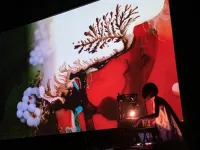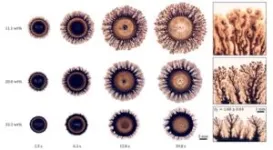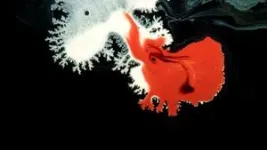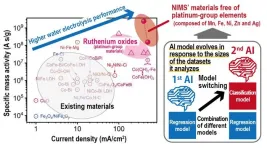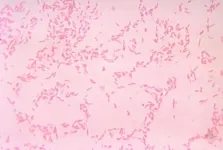(Press-News.org) Falling from the tip of a brush suspended in mid-air, an ink droplet touches a painted surface and blossoms into a masterpiece of ever-changing beauty. It weaves a tapestry of intricate, evolving patterns. Some of them resemble branching snowflakes, thunderbolts or neurons, whispering the unique expression of the artist's vision.
Okinawa Institute of Science and Technology (OIST) researchers set out to analyse the physical principles of this fascinating technique, known as dendritic painting. They took inspiration from the artwork of Japanese media artist, Akiko Nakayama. During her live painting performances, she applies colourful droplets of acrylic ink mixed with alcohol atop a flat surface coated with a layer of acrylic paint. Beautiful fractals – tree-like geometrical shapes that repeat at different scales and are often found in nature – appear before the eyes of the audience. This is a captivating art form driven by creativity, but also by the physics of fluid dynamics.
“I have a deep admiration for scientists, such as Ukichiro Nakaya and Torahiko Terada, who made remarkable contributions to both science and art. I was very happy to be contacted by OIST physicist Chan San To. I am envious of his ability ‘to dialogue’ with the dendritic patterns, observing how they change shape in response to different approaches. Hearing this secret conversation was delightful,” explains Nakayama.
“Painters have often employed fluid mechanics to craft unique compositions. We have seen it with David Alfaro Siqueiros, Jackson Pollock, and Naoko Tosa, just to name a few. In our laboratory, we reproduce and study artistic techniques, to understand how the characteristics of the fluids influence the final outcome,” says OIST Professor Eliot Fried of OIST’s Mechanics and Materials Unit, who likes looking at dendritic paintings from artistic and scientific angles.
See a video of experiments with acrylic paint fractals here.
In dendritic painting, the droplets made of ink and alcohol experience various forces. One of them is surface tension – the force that makes rain droplets spherical in shape, and allows leaves to float on the surface of a pond. In particular, as alcohol evaporates faster than water, it alters the surface tension of the droplet. Fluid molecules tend to be pulled towards the droplet rim, which has higher surface tension compared to its centre. This is called the Marangoni effect and is the same phenomenon responsible for the formation of wine tears – the droplets or streaks of wine that form on the inside of a wine glass after swirling or tilting.
Secondly, the underlying paint layer also plays an important part in this artistic technique. Dr. Chan tested various types of liquids. For fractals to emerge, the liquid must be a fluid that decreases in viscosity under shear strain, meaning it has to behave somewhat like ketchup. It's common knowledge that it's hard to get ketchup out of the bottle unless you shake it. This happens because ketchup's viscosity changes depending on shear strain. When you shake the bottle, the ketchup becomes less viscous, making it easier to pour it onto your dish. How is this applied to dendritic painting?
“In dendritic painting, the expanding ink droplet shears the underlying acrylic paint layer. It is not as strong as the shaking of a ketchup bottle, but it is still a form of shear strain. As with ketchup, the more stress there is, the easier it is for the ink droplets to flow,” explains Dr. Chan.
“We also showed that the physics behind this dendritic painting technique is similar to how liquid travels in a porous medium, such as soil. If you were to look at the mix of acrylic paint under the microscope, you would see a network of microscopic structures made of polymer molecules and pigments. The ink droplet tends to find its way through this underlying network, travelling through paths of least resistance, that leads to the dendritic pattern,” adds Prof. Fried.
Each dendritic print is one-of-a-kind, but there are at least two key aspects that artists can take into consideration to control the outcome of dendritic painting. The first and most important factor is the thickness of the paint layer spread on the surface. Dr. Chan observed that well-refined fractals appear with paint layer thinner than a half millimetre.
The second factor to experiment with is the concentration of diluting medium and paint in this paint layer. Dr. Chan obtained the most detailed fractals using three parts diluting medium and one part paint, or two parts diluting medium and one part paint. If the concentration of paint is higher, the droplet cannot spread well. Conversely, if the concentration of paint is lower, fuzzy edges will form.
This is not the first science-meets-art project that members of the Mechanics and Materials Unit have embarked on. For example, they designed and installed a mobile sculpture on the OIST campus. The sculpture exemplifies a family of mechanical devices, called Möbius kaleidocycles, invented in the Unit, which may offer guidelines for designing chemical compounds with novel electronic properties.
Currently, Dr. Chan is also developing novel methods of analysing how the complexity of a sketch or painting evolves during its creation. He and Prof. Fried are optimistic that these methods might be applied to uncover hidden structures in experimentally captured or numerically generated images of flowing fluids.
“Why should we confine science to just technological progress?” wonders Dr. Chan. “I like exploring its potential to drive artistic innovation as well. I do digital art, but I really admire traditional artists. I sincerely invite them to experiment with various materials and reach out to us if they're interested in collaborating and exploring the physics hidden within their artwork.”
Instructions to create dendritic painting at home
Everybody can have fun creating dendritic paintings. The materials needed include a non-absorbent surface (glass, synthetic paper, ceramics, etc.), a brush, a hairbrush, rubbing alcohol (iso-propyl alcohol), acrylic ink, acrylic paint and pouring medium.
Dilute one part of acrylic paint to two or three parts of pouring medium, or test other ratios to see how the result changes
Apply this to the non-absorbent surface uniformly using a hairbrush. OIST physicists have found out that the thickness of the paint affects the result. For the best fractals, a layer of paint thinner than half millimetre is recommended.
Mix rubbing alcohol with acrylic ink. The density of the ink may differ for different brands: have a try mixing alcohol and ink in different ratios
When the white paint is still wet (hasn’t dried yet), apply a droplet of the ink with alcohol mix using a brush or another tool, such as a bamboo stick or a toothpick.
Enjoy your masterpiece as it develops before your eyes. END
Beyond the ink: Painting with physics
Scientifically-proven suggestions for crafting a masterpiece.
2024-03-02
ELSE PRESS RELEASES FROM THIS DATE:
Only 9 percent of older Americans were vaccinated against RSV before the disease hit this fall and winter
2024-03-02
A new study from the Texas A&M University School of Public Health found that only 9 percent of older Americans had been vaccinated against respiratory syncytial virus (RSV) prior to this fall and winter, despite the threat of increased rates of hospitalization and deaths nationwide from the virus.
“RSV—along with COVID-19 and influenza—form the current ‘tripledemic’ found across the United States this fall and winter,” said Simon Haeder, PhD, the study’s author. “While the elderly, as well as the very young and those with chronic health conditions, typically are affected ...
Evolution-capable AI promotes green hydrogen production using more abundant chemical elements
2024-03-02
1. A NIMS research team has developed an AI technique capable of expediting the identification of materials with desirable characteristics. Using this technique, the team was able to discover high-performance water electrolyzer electrode materials free of platinum-group elements—substances previously thought to be indispensable in water electrolysis. These materials may be used to reduce the cost of large-scale production of green hydrogen—a next-generation energy source.
2. Large-scale production of green ...
In wake of powerful cyclone, remarkable recovery of Pacific island’s forests
2024-03-01
After one of the most intense cyclones in world history tore through the Pacific island of Tanna in Vanuatu, new research led by the University of Hawaiʻi at Mānoa showed the resilience of the island’s forests.
In the Pacific islands, climate change is expected to increase the intensity and frequency of cyclones, causing huge potential risks to forests and the people who depend on them. In March 2015, Cyclone Pam touched down on the island of Tanna as the strongest Pacific island cyclone in history ...
PSU study sheds light on 2020 extreme weather event that brought fires and snow to western US
2024-03-01
The same weather system that led to the spread of the devastating Labor Day wildfires in 2020 brought record-breaking cold and early-season snowfall to parts of the Rocky Mountains. Now, new research from Portland State is shedding light on the meteorology behind what happened and the impacts of such an extreme weather event.
“It’s really interesting to see such an amplified pattern result in opposing extremes in the Pacific Northwest and the Rocky Mountains,” said Emma Russell, a master’s student in geography ...
Rice physicist earns NSF CAREER Award to revolutionize quantum technology
2024-03-01
HOUSTON – (March 1, 2024) – Yonglong Xie, assistant professor of physics at Rice University, has been awarded a Faculty Early Career Development (CAREER) Award from the National Science Foundation (NSF). The $888,555 grant over five years will support Xie’s research into harnessing magnons, quantum mechanical wavelike objects in magnetic materials, to create synthetic matter and develop next-generation quantum devices and sensors.
The CAREER program offers NSF’s most prestigious awards in support of early career faculty who have the potential to serve as academic role models in research and education. Xie’s project focuses ...
Mining the treasures locked away in produced water
2024-03-01
In an ironic twist, a treasure trove of critical minerals is dumped out with water considered too polluted and expensive to clean.
Texas A&M University researcher Dr. Hamidreza Samouei is investigating the components of produced water and says this waste byproduct of oil and gas operations contains nearly every element in the periodic table, including those of significant interest to national economies.
His goal is to treat the water using unwanted carbon dioxide (CO2) in stages to recover these valuable elements and ultimately produce fresh water for agricultural use once the processes are complete.
“Recognizing the latent value ...
Minoritized groups face high anxiety when taking part in research experiments
2024-03-01
RIVERSIDE, Calif. -- When participating in research studies, moderately anxious or highly anxious children from minoritized groups are likely to be hypervigilant to threat, further compounding the effects of their general state of anxiety, a research study led by a University of California, Riverside, psychologist reports.
The study, which involved the participation of 46 Inland Southern California preadolescent Latina girls (8–13 years), has implications also for children from families with low socioeconomic status.
“Psychological research is often conducted in white, educated, and affluent communities,” said Kalina Michalska, ...
Orcas demonstrating they no longer need to hunt in packs to take down the great white shark
2024-03-01
An orca (killer whale) has been observed, for the first-ever time, individually consuming a great white shark – and within just two minutes.
“The astonishing predation, off the coast of Mossel Bay, South Africa, represents unprecedented behavior underscoring the exceptional proficiency of the killer whale”, remarks Dr. Alison Towner from Rhodes University, who led an international research team into the discovery.
Their findings are published today in the peer-reviewed African Journal of Marine Science.
The groundbreaking insight is the latest from Dr. Towner and the team, who, in 2022 in the same journal, ...
Scientists discover a novel vehicle for antibiotic resistance
2024-03-01
By David L. Chandler
WOODS HOLE, Mass. -- Antibiotic resistance is a significant and growing medical problem worldwide. Researchers at the Marine Biological Laboratory (MBL) and collaborators have found a novel genetic arrangement that may help a common bacterium in the human gut, Bacteroides fragilis, protect itself from tetracycline, a widely used antibiotic.
While these findings will not lead directly to new ways of combating tetracycline-resistant bacteria, the researchers have discovered previously unseen genetic arrangements that confer antibiotic resistance. Such understanding might help in developing new ways to limit the spread of antibiotic resistance genes, through genetic ...
Large-scale study explores link between smoking and DNA changes across six racial and ethnic groups
2024-03-01
Smoking changes the way genes are expressed, which later contributes to the development of lung cancer and other smoking-related illnesses. But the link between epigenetics (the study of mechanisms that impact gene expression) and smoking is not fully understood, especially in terms of differences across racial and ethnic groups.
“We know that smoking affects people differently based on their race and ethnicity, but identifying epigenetic signatures of smoking would help us better predict risk for smoking-related diseases,” said Brian Huang, PhD, an assistant professor in the department of population ...
LAST 30 PRESS RELEASES:
Microplastics detected in rural woodland
JULAC and Taylor & Francis sign open access agreement to boost the impact of Hong Kong research
Protecting older male athletes’ heart health
KAIST proposes AI-driven strategy to solve long-standing mystery of gene function
Eye for trouble: Automated counting for chromosome issues under the microscope
The vast majority of US rivers lack any protections from human activities, new research finds
Ultrasound-responsive in situ antigen "nanocatchers" open a new paradigm for personalized tumor immunotherapy
Environmental “superbugs” in our rivers and soils: new one health review warns of growing antimicrobial resistance crisis
Triple threat in greenhouse farming: how heavy metals, microplastics, and antibiotic resistance genes unite to challenge sustainable food production
Earthworms turn manure into a powerful tool against antibiotic resistance
AI turns water into an early warning network for hidden biological pollutants
Hidden hotspots on “green” plastics: biodegradable and conventional plastics shape very different antibiotic resistance risks in river microbiomes
Engineered biochar enzyme system clears toxic phenolic acids and restores pepper seed germination in continuous cropping soils
Retail therapy fail? Online shopping linked to stress, says study
How well-meaning allies can increase stress for marginalized people
Commercially viable biomanufacturing: designer yeast turns sugar into lucrative chemical 3-HP
Control valve discovered in gut’s plumbing system
George Mason University leads phase 2 clinical trial for pill to help maintain weight loss after GLP-1s
Hop to it: research from Shedd Aquarium tracks conch movement to set new conservation guidance
Weight loss drugs and bariatric surgery improve the body’s fat ‘balance:’ study
The Age of Fishes began with mass death
TB harnesses part of immune defense system to cause infection
Important new source of oxidation in the atmosphere found
A tug-of-war explains a decades-old question about how bacteria swim
Strengthened immune defense against cancer
Engineering the development of the pancreas
The Journal of Nuclear Medicine ahead-of-print tip sheet: Jan. 9, 2026
Mount Sinai researchers help create largest immune cell atlas of bone marrow in multiple myeloma patients
Why it is so hard to get started on an unpleasant task: Scientists identify a “motivation brake”
Body composition changes after bariatric surgery or treatment with GLP-1 receptor agonists
[Press-News.org] Beyond the ink: Painting with physicsScientifically-proven suggestions for crafting a masterpiece.
